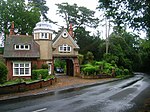Seaview Wildlife Encounter
1971 establishments in England2015 disestablishments in EnglandIsle of Wight geography stubsNature reserves on the Isle of WightTourist attractions on the Isle of Wight ... and 2 more
Use British English from June 2015Zoos in England

Seaview Wildlife Encounter, (formerly Flamingo Park), was a wildlife park featuring non-native species of birds and mammals. It opened in 1971 and closed in November 2015. The visitor attraction was located in the town of Seaview, on the northeast coast of the Isle of Wight. The Isle of Wight is a small British island 3 to 5 mi (5 to 8 km) off the coast of South East England.
Excerpt from the Wikipedia article Seaview Wildlife Encounter (License: CC BY-SA 3.0, Authors, Images).Seaview Wildlife Encounter
Oakhill Road,
Geographical coordinates (GPS) Address Nearby Places Show on map
Geographical coordinates (GPS)
| Latitude | Longitude |
|---|---|
| N 50.720555555556 ° | E -1.1233333333333 ° |
Address
Oakhill Road
PO34 5AL , Nettlestone and Seaview
England, United Kingdom
Open on Google Maps









